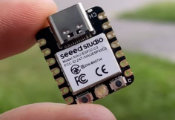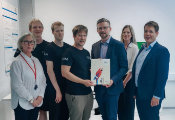Classiq Demonstrates Up to 95% Circuit Compression for Monte Carlo Simulations
TEL AVIV, Israel, March 25, 2025 -- Classiq Technologies has reported that its quantum circuit compression tools achieved up to 95% reduction in circuit depth for quantum Monte Carlo simulations in a financial modeling study with Sumitomo Corporation and Mizuho–DL Financial Technology. The project evaluated how Classiq’s platform could support more resource-efficient implementations of Monte Carlo methods used in credit risk analysis.
In the financial industry, Monte Carlo simulations are widely used for derivative pricing and asset risk evaluation. However, these simulations require the generation of vast scenarios using random numbers, leading to high computational costs and long processing times. Quantum computing has the potential to efficiently handle large-scale probabilistic simulations compared to conventional methods, offering significant benefits in speeding up simulations and improving risk assessment accuracy.
This project explored the use of Classiq’s technology to generate more efficient quantum circuits for a novel quantum Monte Carlo simulation algorithm incorporating pseudo-random numbers proposed by Mizuho-DL FT. The project aimed to evaluate the feasibility of implementing quantum algorithms in financial applications in the future.
Quantum Monte Carlo simulations are expected to be used in finance for risk metrics such as Value at Risk (VaR), enabling fast and accurate credit portfolio risk assessments. In this project, two types of quantum Monte Carlo simulations were implemented:
- Traditional Monte Carlo simulation.
- Pseudo-random number-based Monte Carlo simulation proposed by Mizuho-DL FT.
The goal of the study was to optimize quantum circuits by comparing the two simulation methods.
In traditional methods, each random number requires a dedicated quantum bit (qubit), leading to a large number of qubits. In contrast, the pseudo-random number method generates necessary random patterns in stages, reducing the required qubit count. However, this reduction can lead to deeper circuits, introducing a trade-off in circuit design.
To address this, Classiq’s quantum circuit compression technology was applied to assess whether the circuits generated for both types of Monte Carlo simulations could be further optimized. Specifically, quantum circuits generated with conventional techniques were compared with those designed using Classiq’s high-level quantum language, Qmod. The evaluation considered qubit usage, circuit depth and computational accuracy.
The results demonstrated that both approaches achieved up to 95% compression without significantly increasing qubit count. This demonstrates the potential for efficient and high-precision risk assessment using limited quantum resources.
Results
A quantum circuit is the structured implementation of an algorithm on a quantum computer, composed of qubits and quantum gates that operate on them. The longer the quantum circuit, the greater the error rate and the higher the hardware resource consumption, making quantum circuit compression a critical challenge for improving the efficiency of quantum algorithm implementation.
In this project, significant compression was achieved in quantum circuits for two types of quantum Monte Carlo simulations designed for credit portfolio risk management. Both simulations improved computational efficiency on quantum hardware and enhanced scalability for larger financial problems.
By enabling high-precision calculations with fewer resources, the study demonstrated that large-scale probabilistic simulations for financial risk management may be feasible. Additionally, the reduced circuit depth improved fault tolerance, minimizing the impact of noise.




































